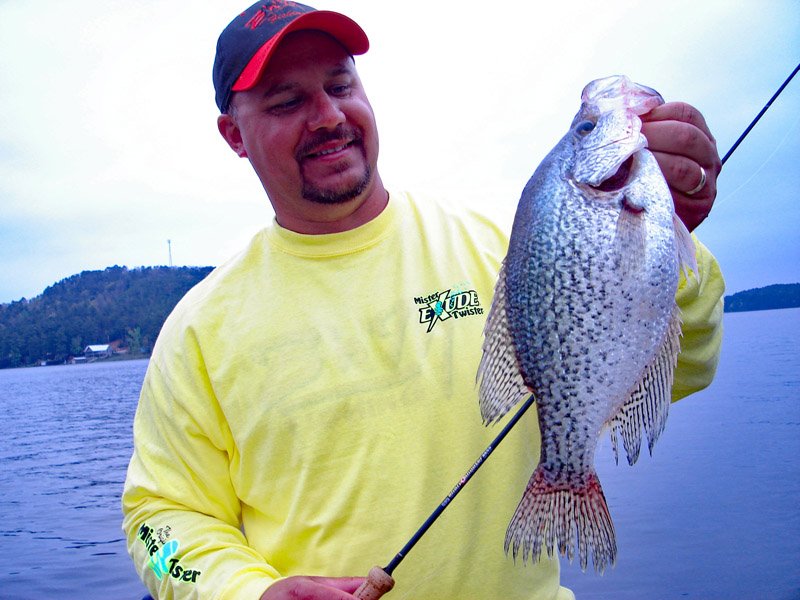Double jig rigs will work well for jigging over structure. (Photo: Ed Mashburn)
Winter Open Water Crappie
by Ed Mashburn
Don’t Sweat the Cold
It’s cold and the wind is blowing. The warm, pleasant days of spring and the red-hot spawning crappie bite are long over. But don’t be overly tempted to settle in watching football on TV. There are still crappie to be caught.
Where to Find Them
Brad Whitehead is a guide on Pickwick Lake in Tennessee and Mississippi, one of the chain of wonderful Tennessee River lakes which provide such great year-round crappie fishing.

Pickwick Lake is a big, big lake, and finding the fish when they’ve gone to their wintertime haunts can be tough. But Whitehead says crappie are creatures of habit. Find a good wintertime spot and chances are you can return to it year-after-year.
“I go back to my past experience,” said Whitehead. “Where I found crappie in open water in winter in years before, I can usually find them at the same places now. In general, I look for deep flats and creek channels. On the flats, I look for structure that I can work, and on the deeper creek channels, I’m looking for suspended fish.”
On other Tennessee River reservoirs, many wintertime anglers seek out rock bluffs. Winter crappie often stack on steep bluffs, especially when there is good current flow through the reservoir. Current flow tends to force crappie to gang up in eddies where small points or outcroppings break the current.
Crappie are looking for easy meals with good return for their efforts.
What are the Slabs Eating?
Since crappie don’t like to be far from their primary food sources, it’s crucial for anglers who want to catch good cold-weather open water crappie to know what sort of forage the crappie are working.
It can’t be overstated that on most large lakes, especially in wintertime open-water situations, finding the shad is crucial to locating the crappie.

Whitehead tells us that in winter, shad- bigger shad- are the primary food for most lake crappie, and anglers will want to match the size of their lures to the size of the shad. Whitehead says that in winter, the shad have grown out and they are pretty good size.
Crappie are looking for easy meals with good return for their effort. Anglers will want to go to jigs and other lures with larger size- about two-inches- when working the open water crappie.
Deep running crankbaits can be very effective when working the deep creek channels for the suspended crappie, and by varying speed of the retrieve and depth of the lures, the best depth, lure size, and retrieve speed can be identified.
Bright colors for crankbaits can be a very good idea for wintertime situations, too.
What Kind of Rig will Catch Them?
In cold weather, open water fishing for crappie, Whitehead falls back on tried and true rigging. Basically, he uses a one-rod, one-angler approach for vertical jigging over structure on flats, and he slow-trolls over creek channels.
Whitehead says, “ I like to side-pull using multiple poles with two-jigs per pole. I can fish up to nine rods at one time if I have three anglers aboard.
The color of the jigs will vary day to day, and by having more than one angler fishing, the best color and size of jig can be found fairly quickly.
Whitehead says, “I like to use a Charlie Brewer Double Action Slider in 2 1/8 oz size when side-pulling.”
When jigging over deep flats structure, Whitehead relies on Slab Magnet jigs made by Crappie Magnet, and he advises anglers to work the jig with sharp action and plenty of motion in cold water situations. The crappie have lots of shad to eat, and the jig has to present something that gets the attention of the fish to entice them to strike. And Whitehead tells us that in winter, the crappie often strike hard and with a surprising amount of energy in the cold water.
And Something to Think About
We all love early morning fishing trips, watching the sun come up, and the day getting off to a good start. However, in winter, early morning may not be the best time to go after open water crappie.
Brad Whitehead says, “I think fishing in the afternoon is something guys don’t think about. I like afternoon guide trips. The water is normally warmer and schools of shad are moving in the warmer water.”
Not to mention, cold winter days tend to be just a bit warmer and more pleasant for anglers in the afternoon, too.
(Ed Mashburn is a retired public school teacher, outdoor writer and photographer. He lives in southern Alabama, but he fishes for anything – carp and trout in Arizona, smallmouth bass and crappie in Wisconsin to snook and snapper in the Florida Keys.)


